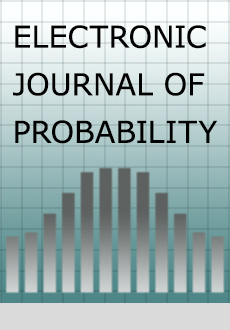Abstract
We consider the spatially inhomogeneous Moran model with seed-banks introduced in [20]. Populations comprising active and dormant individuals are spatially structured in colonies labeled by . The population sizes are sampled from a translation-invariant, ergodic, uniformly elliptic field that constitutes a static random environment. Individuals carry one of two types: ♡ and ♠. Dormant individual resides in what is called a seed-bank. Active individuals exchange type from the seed-bank of their own colony, and resample type by choosing a parent uniformly at random from the distinct active populations according to a symmetric migration kernel. In [20] by exploiting a dual process given by an interacting coalescing particle system, we showed that the spatial system exhibits a dichotomy between clustering (mono-type equilibrium) and coexistence (multi-type equilibrium). In this paper, we identify the domain of attraction for each mono-type equilibrium in the clustering regime for an arbitrary fixed environment. Furthermore, we show that in dimensions , when the migration kernel is recurrent, for almost all realization of the environment, the system with an initially consistent type-distribution converges weakly to a mono-type equilibrium in which the probability of fixation to the all type-♡ configuration does not depend on the environment. An explicit formula for the fixation probability is given in terms of an annealed average of the type-♡ densities in the active and the dormant population, biased by the ratio of the two population sizes at the target colony.
Primary techniques employed in the proofs include stochastic duality and the environment process viewed from particle, introduced in [24] for random walk in random environment on a strip. A spectral analysis of Markov operator yields quenched weak convergence of the environment process associated with the single-particle dual process to a reversible ergodic distribution, which we transfer to the spatial system of populations by using duality.
Funding Statement
Supported by the Netherlands Organisation for Scientific Research (NWO) through grant TOP1.17.019.
Acknowledgments
The author thanks his advisor Frank den Hollander for suggesting the problem and appreciates his continuous encouragement during many inspiring discussions. The author thanks Evgeny Verbitskiy for several discussions on ergodic theory in the past, and for pointing out the reference [17] which was very helpful for the present paper. The author also thanks Yuval Peres for providing (at online forum math.stackexchange.com) the reference [43] that relates weak convergence of Markov chains to the peripheral spectrum of Markov operators. The author thanks Rajat Hazra for insightful discussions. Furthermore, the author thanks Frank Redig, Cristian Giardinà and Simone Floreani for discussions on duality. The author also thanks the two anonymous referees for their careful reading of the manuscript and the useful suggestions.
Citation
Shubhamoy Nandan. "Spatial populations with seed-banks in random environment: III. Convergence towards mono-type equilibrium." Electron. J. Probab. 28 1 - 36, 2023. https://doi.org/10.1214/23-EJP922
Information





